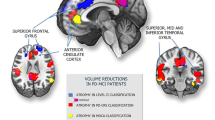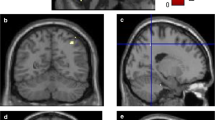Abstract
The “applause sign” is a motor perseveration described in focal and neurodegenerative disorders and characterized by fronto-subcortical dysfunction. Most previous formal investigations focused on Parkinson’s disease or progressive supranuclear palsy. We assessed the prevalence of the applause sign in patients affected by Alzheimer’s disease (AD), Lewy body dementia (LBD), corticobasal syndrome (CBS), and posterior cortical atrophy (PCA), with the aim to verify its contribution to the differential diagnosis. We enrolled 20 patients with AD, 20 with LBD, 16 with CBS, and ten with PCA, and 30 healthy controls. The three clap test (TCT) was used to elicit the applause sign, and was scored by raters blinded to the diagnosis. Correlation with motor (extrapyramidal) and cognitive measures was also performed. A maximum 40 % prevalence of a positive applause sign was found in the two parkinsonian syndromes, which could be discriminated from the two cortical groups with a positive predictive value of 82 % and a negative predictive value of 55 %. According to our findings, a diagnosis of LBD or CBS, rather than of AD or PCA, is highly probable in the presence of an abnormal TCP, but cannot be ruled out based on a negative result. No relevant correlates emerged that could clarify the origin and nature of the applause sign.
Similar content being viewed by others
References
Dubois B, Slachevsky A, Pillon B, Beato R, Villalponda JM, Litvan I (2005) “Applause sign” helps to discriminate PSP from FTD and PD. Neurology 64:2132–2133
Abdo WF, van Norden AG, de Laat KF et al (2007) Diagnostic accuracy of the clapping test in Parkinsonian disorders. J Neurol 254:1366–1369
Dubois B, Defontaines B, Deweer B, Malapani C, Pillon B (1995) Cognitive and behavioral changes in patients with focal lesions of the basal ganglia. Adv Neurol 65:29–41
Dubois B, Funkiewiecz A, Pillon B (2005) Behavioral changes in patients with focal lesions of the basal ganglia. Adv Neurol 96:17–25
Luzzi S, Fabi K, Pesallaccia M, Silvestrini M, Provinciali L (2011) Applause sign: is it really specific for Parkinsonian disorders? Evidence from cortical dementias. J Neurol Neurosurg Psych 82:830–833
Maraganore DM, Lees AJ, Marsden CD (1991) Complex stereotypies after right putaminal infarction: a case report. Mov Disord 6:358–361
Walsh RA, Duggan J, Lynch T (2011) Localisation of the applause sign in a patient with acute bilateral lenticular infarction. J Neurol 258:1180–1182
Gallagher DA, Schott JM, Childerhouse A, Wilhelm T, Gale AN, Schrag A (2008) Reversible “applause sign” secondary to diffuse large B cell lymphoma. Mov Disord 23:2426–2428
Kuniyoshi S, Riley DE, Zee DS, Reich SG, Whitney C, Leigh RJ (2002) Distinguishing progressive supranuclear palsy from other forms of Parkinson’s disease: evaluation of new signs. Ann NY Acad Sci 956:484–486
Wu LJ, Sitburana O, Davidson A, Jankovic J (2008) Applause sign in Parkinsonian disorders and Huntington’s disease. Mov Disord 23:2307–2311
Aarsland D, Rongve A, Nore SP et al (2008) Frequency and case identification of dementia with Lewy bodies using the revised consensus criteria. Dement Geriatr Cogn Disord 26:445–452
Crutch SJ, Lehmann M, Schott JM, Rabinovici GD, Rossor MN, Fox NC (2012) Posterior cortical atrophy. Lancet Neurol 11:170–178
Boeve BF, Lang AE, Litvan I (2003) Corticobasal degeneration and its relationship to progressive supranuclear palsy and frontotemporal dementia. Ann Neurol 54(Suppl 5):S15–S19
Dubois B, Feldman HH, Jacova C et al (2005) Research criteria for the diagnosis of Alzheimer’s disease: revising the NINCDS-ADRDA criteria. Lancet Neurol 6:734–746
McKeith IG, Dickson DW, Lowe J et al (2005) Diagnosis and management of dementia with Lewy bodies: third report of the DLB Consortium. Neurology 65:1863–1872
McMonagle P, Deering F, Berliner Y, Kertesz A (2006) The cognitive profile of posterior cortical atrophy. Neurology 66:331–338
De Renzi E, Motti F, Nichelli P (1980) Imitating gestures. A quantitive approach in ideomotor apraxia. Arch Neurol 37:6–10
Acknowledgments
We thank Diletta Cereda and Silvia Fossati for having viewed and rated patients’ and controls’ videos.
Conflicts of interest
None.
Author information
Authors and Affiliations
Corresponding author
Rights and permissions
About this article
Cite this article
Isella, V., Rucci, F., Traficante, D. et al. The applause sign in cortical and cortical-subcortical dementia. J Neurol 260, 1099–1103 (2013). https://doi.org/10.1007/s00415-012-6767-0
Received:
Revised:
Accepted:
Published:
Issue Date:
DOI: https://doi.org/10.1007/s00415-012-6767-0




